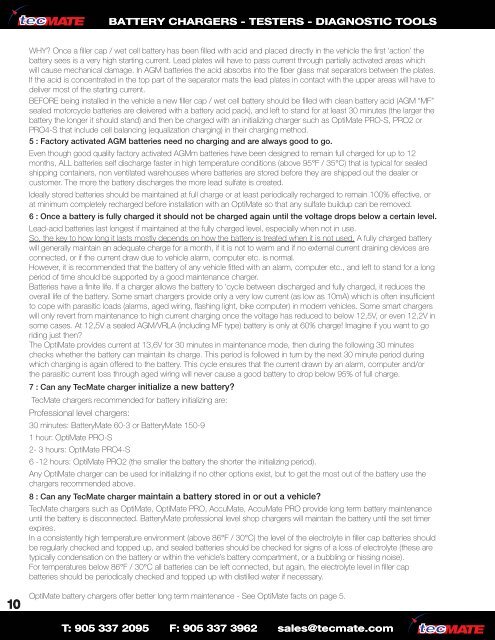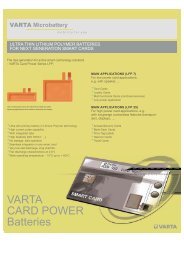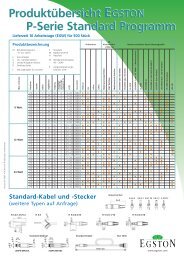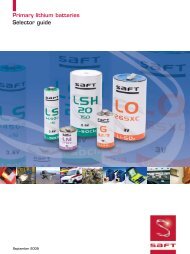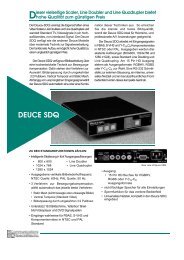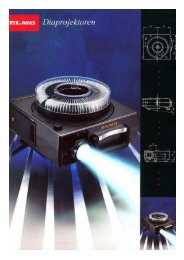BATTERY CHARGERS DIAGNOSTIC TOOLS BATTERY TESTERS
BATTERY CHARGERS DIAGNOSTIC TOOLS BATTERY TESTERS
BATTERY CHARGERS DIAGNOSTIC TOOLS BATTERY TESTERS
Create successful ePaper yourself
Turn your PDF publications into a flip-book with our unique Google optimized e-Paper software.
10<br />
<strong>BATTERY</strong> <strong>CHARGERS</strong> - <strong>TESTERS</strong> - <strong>DIAGNOSTIC</strong> <strong>TOOLS</strong><br />
WHY? Once a fi ller cap / wet cell battery has been fi lled with acid and placed directly in the vehicle the fi rst ‘action’ the<br />
battery sees is a very high starting current. Lead plates will have to pass current through partially activated areas which<br />
will cause mechanical damage. In AGM batteries the acid absorbs into the fi ber glass mat separators between the plates.<br />
If the acid is concentrated in the top part of the separator mats the lead plates in contact with the upper areas will have to<br />
deliver most of the starting current.<br />
BEFORE being installed in the vehicle a new fi ller cap / wet cell battery should be fi lled with clean battery acid (AGM “MF”<br />
sealed motorcycle batteries are dleivered with a battery acid pack), and left to stand for at least 30 minutes (the larger the<br />
battery the longer it should stand) and then be charged with an initializing charger such as OptiMate PRO-S, PRO2 or<br />
PRO4-S that include cell balancing (equalization charging) in their charging method.<br />
5 : Factory activated AGM batteries need no charging and are always good to go.<br />
Even though good quality factory activated AGMm batteries have been designed to remain full charged for up to 12<br />
months, ALL batteries self discharge faster in high temperature conditions (above 95°F / 35°C) that is typical for sealed<br />
shipping containers, non ventilated warehouses where batteries are stored before they are shipped out the dealer or<br />
customer. The more the battery discharges the more lead sulfate is created.<br />
Ideally stored batteries should be maintained at full charge or at least periodically recharged to remain 100% effective, or<br />
at minimum completely recharged before installation with an OptiMate so that any sulfate buildup can be removed.<br />
6 : Once a battery is fully charged it should not be charged again until the voltage drops below a certain level.<br />
Lead-acid batteries last longest if maintained at the fully charged level, especially when not in use.<br />
So, the key to how long it lasts mostly depends on how the battery is treated when it is not used. A fully charged battery<br />
will generally maintain an adequate charge for a month, if it is not to warm and if no external current draining devices are<br />
connected, or if the current draw due to vehicle alarm, computer etc. is normal.<br />
However, it is recommended that the battery of any vehicle fi tted with an alarm, computer etc., and left to stand for a long<br />
period of time should be supported by a good maintenance charger.<br />
Batteries have a fi nite life. If a charger allows the battery to ‘cycle between discharged and fully charged, it reduces the<br />
overall life of the battery. Some smart chargers provide only a very low current (as low as 10mA) which is often insuffi cient<br />
to cope with parasitic loads (alarms, aged wiring, fl ashing light, bike computer) in modern vehicles. Some smart chargers<br />
will only revert from maintenance to high current charging once the voltage has reduced to below 12,5V, or even 12,2V in<br />
some cases. At 12,5V a sealed AGM/VRLA (including MF type) battery is only at 60% charge! Imagine if you want to go<br />
riding just then?<br />
The OptiMate provides current at 13,6V for 30 minutes in maintenance mode, then during the following 30 minutes<br />
checks whether the battery can maintain its charge. This period is followed in turn by the next 30 minute period during<br />
which charging is again offered to the battery. This cycle ensures that the current drawn by an alarm, computer and/or<br />
the parasitic current loss through aged wiring will never cause a good battery to drop below 95% of full charge.<br />
7 : Can any TecMate charger initialize a new battery?<br />
TecMate chargers recommended for battery initializing are:<br />
Professional level chargers:<br />
30 minutes: BatteryMate 60-3 or BatteryMate 150-9<br />
1 hour: OptiMate PRO-S<br />
2- 3 hours: OptiMate PRO4-S<br />
6 -12 hours: OptiMate PRO2 (the smaller the battery the shorter the initializing period).<br />
Any OptiMate charger can be used for initializing if no other options exist, but to get the most out of the battery use the<br />
chargers recommended above.<br />
8 : Can any TecMate charger maintain a battery stored in or out a vehicle?<br />
TecMate chargers such as OptiMate, OptiMate PRO, AccuMate, AccuMate PRO provide long term battery maintenance<br />
until the battery is disconnected. BatteryMate professional level shop chargers will maintain the battery until the set timer<br />
expires.<br />
In a consistently high temperature environment (above 86°F / 30°C) the level of the electrolyte in fi ller cap batteries should<br />
be regularly checked and topped up, and sealed batteries should be checked for signs of a loss of electrolyte (these are<br />
typically condensation on the battery or within the vehicle’s battery compartment, or a bubbling or hissing noise).<br />
For temperatures below 86°F / 30°C all batteries can be left connected, but again, the electrolyte level in fi ller cap<br />
batteries should be periodically checked and topped up with distilled water if necessary.<br />
OptiMate battery chargers offer better long term maintenance - See OptiMate facts on page 5.<br />
T: 905 337 2095 F: 905 337 3962 sales@tecmate.com


